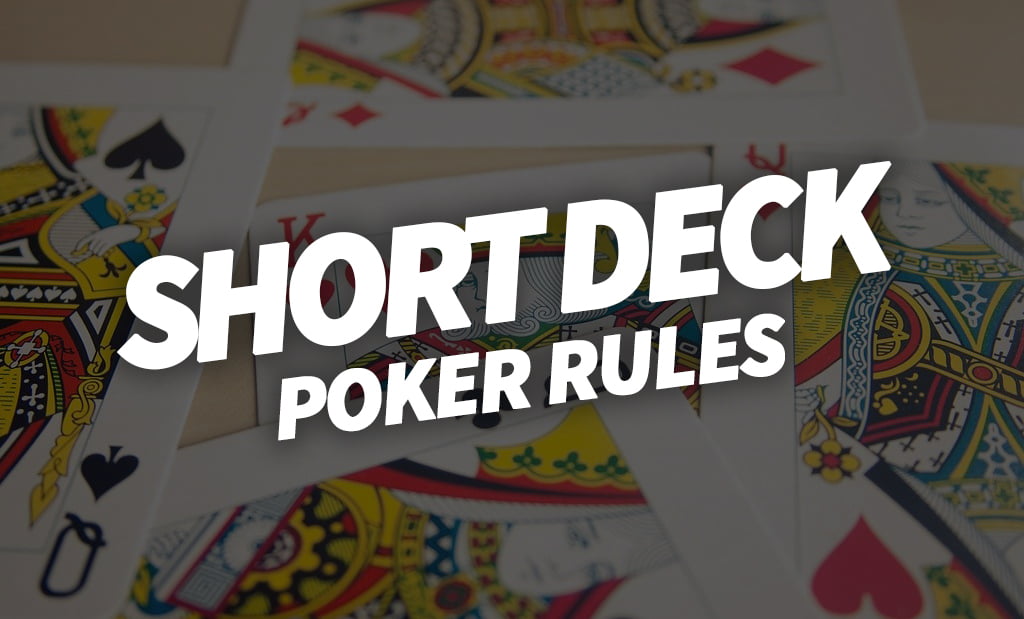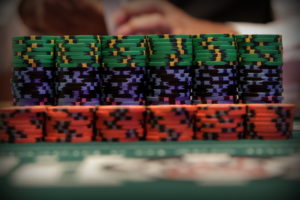Short Deck Poker
Short Deck is an increasingly popular variation of poker which uses just 36 cards. The game plays similarly to Texas Hold’em, however the reduced deck opens up a whole new level of strategy! Some Tips for Getting into Short Deck Poker This game is one of the hottest in the world right now, dominating high roller action with the likes of Triton series hosting huge games. Check out these introductory tips if you want to start crushing the games. Click to view the Post.
PokerStars appears to be bringing the popular new poker variant, Six Plus Hold’em or Short Deck Poker, to its platform soon, according to a report at PokerFuse.
In recent months, the game has gained some traction in cash games and on the tournament scene in southeast Asia among high rollers. Some of the most well-known players in the world have gotten in on the Six Plus (Short Deck) bandwagon, including Tom Dwan and Phil Ivey, who began playing the game in 2015 in Macau.
It appears PokerStars is now bringing the game to the masses and began utilizing a Six Plus graphic recently to promote the new offering.
What is Six-Plus Hold’em?
For the uninitiated, Six Plus is quite a bit different than traditional Texas Hold’em. Deuces through fives are taken out of the deck and then the game follows the traditional hold’em format. The removal of those low cards makes for only a 36-card deck, and even changes the math of the game.
In fact, the deck’s alteration also changes the ranking of hands, with straights now ranked higher than flushes in Short Deck. With so many higher cards now, players’ odds to make much stronger hands increase – creating more action and some say a bit more gamble than traditional hold’em. Ivey said as much to PaulPhuapoker.com last year.
“There’s a lot of gambling involved,” he said. “The equities run pretty close, so it’s pretty easy to get your money in the middle and be 50/50 or somewhere near that. It suits a more gambling style of player.”
Will the short deck action attract a following on PokerStars? Time will tell, but the site has been looking to expand its offerings in recent months, trying to offer more variants to entice more players to the tables with fresh games.
The site recently launched three new games: Unfold, Split Hold’em, and Showtime Hold’em. Here’s a look at the theory behind those three games:
- Unfold Hold’em – PokerStars’ newest offering for cash game players, Unfold gives players another chance to win – even players who have folded their hands.Before the hand, each player pays an Unfold ante to form a side pot. All players who folded pre-flop are given the chance to “Unfold” when the flop is dealt, but must pay the Unfold bet – the sum of the side pot with no further betting. The winning “folded” hand after the river wins the side pot.
- Split Hold’em– Also available in cash games, this form of hold’em calls for two flops, two turns, and two rivers. Players must make the best hand on both boards to win the whole pot, thus the “split.”
- Showtime Hold’em – This game is also played like traditional Texas Hold’em except when a player folds a hand, it’s showtime – those are revealed for everyone at the table. Folded hands remain face up and visible throughout the rest of the hand. The revelations could alter strategy and information available on other players at the table.
Six-Plus becomes just the latest in the ever-expanding stable of PokerStars hold’em games. However, no timetable has been offered yet on when Six Plus will make its debut on the site.
Recently I’ve been hearing about a new game called short deck. It’s played just like normal Texas hold’em, except it’s played with a short deck—all the cards deuce through five are removed from the deck. Aces play as the low end of a nine-high straight. Some variants reorder the hand rankings, most notably changing it so that flushes beat a full house.
When I first heard about it, it sounded to me like the new math would break a lot of players’ intuition they’ve built playing regular no-limit hold’em. So the first thing I wanted to do was go through how some of the math changes.
How To Play Short Deck Poker
Let’s say you get dealt 10h 9h. Let’s go through the math of how often you flop straight and/or flush draws both for normal hold’em and then for short deck.


Full Deck Draws
Once you have your two cards, 50 cards remain in the deck. Three of these will appear on the flop, so there are 50 choose 3 total possible flops. (You can type 50 choose 3 into Google and it will give you the answer.) In this case, that’s 19,600 possible flops.
To flop a flush draw, you need two of the 11 remaining hearts on the flop, as well as an unrelated third card. So that’s 11 choose 2 times 39 (the number of non-hearts remaining in the deck). Since 11 choose 2 is 55, the total number of flush draw flops is 2,145. Divide that by the total number of flops, and you get about 11 percent, which is how often you will flop a flush draw.
To flop an open-ended straight draw you need either Q-J, J-8, or 8-7 on the flop—in each case also with an unrelated card. There are 16 ways to have Q-J (four queens times four jacks), and 16 ways each for the other two for 48 total ways.
Short Deck Poker
If we specify that the unrelated card can’t be one that completes the straight, there are 40 possible unrelated cards for each of the 48 total ways to flop a straight draw. That makes 1,920 total straight draw flops. Divide that by the total number of flops, and you get about 10 percent, which is how often you will flop a straight draw.
Short Deck Draws

In short deck, there are 34 remaining cards after you get your two, so 34 choose 3 or 5,984 possible flops.
There are only 7 remaining hearts, so to flop a flush draw you have 7 choose 2 times 27 possible flops. That’s 567 flops or about 9.5 percent of flops. The full deck chance was 11 percent so flush draws are somewhat less common in short deck.
To flop a straight draw you still have your 48 ways to get Q-J, J-8, or 8-7 on the flop, but now there are only 24 unrelated third cards. That’s 1,152 total straight draw flops or about 19 percent. The chance of flopping a straight draw in short deck is much higher than it is with a full deck.
Making The Draw
Everyone knows the chance to make flush and straight draws in normal hold’em are nine and eight outs respectively. You can use the rule of two and four to estimate the chance of making the draws. But the exact way to figure it out is to do something similar to what we did on the flop. The only twist is you calculate the chance of missing the draw and then subtract that from one.
There are 47 choose 2 possible turn and river cards. That’s 1,081. If you have a flush draw (nine outs) then there are 38 cards that brick your draw, so you have 38 choose 2 ways to miss. That’s 703 total misses out of 1,081, or 65 percent. That leaves a 35 percent chance you hit your flush draw.
Straights work the same, except you have 39 cards that brick your draw. That’s 741 total misses, or 68.5 percent. That leaves a 31.5 percent chance of hitting the draw.
In short deck, there are 31 choose 2 possible turn and river cards. That’s 465. A flush draw has only five outs in this game. So there are 26 cards that brick your draw, and you have 26 choose 2 ways to miss, or 325. That’s about a 70 percent chance to miss, so it’s about a 30 percent chance to make a flush.
Open-ended straights still have 8 outs though. So there are only 23 cards that brick your draw, giving you 23 choose 2 ways to miss, or 253. That’s about a 54.5 percent miss percentage, so you hit your straight about 45.5 percent of the time.
That’s pretty close to 50-50! And you flop a straight draw to your connector nearly 20 percent of the time. Flushes are a bit harder to make in this game, but straights are much easier.
Flopping A Set
The odds of flopping a set change also in short deck. You can figure it out the same way as the chance of making draws—count the flops where you miss the set and subtract from one. With a full deck, there are 48 choose 3 ways to miss your set, or 17,296. That’s about 88 percent of flops, leaving about a 12 percent chance to flop a set.
In short deck, there are 32 choose 3 ways to miss your set, or 4,960 flops. Divide that by the 5,984 total possible short deck flops, and there’s about an 83 percent chance to miss, leaving a 17 percent chance to flop a set.
Final Thoughts
I don’t know how many of us will be playing short deck soon. The game is popular in only a small number of places, mostly in ultra high-stakes cash games. I think one reason it’s become popular in those games is because it turns your ingrained intuitions against you.
Short Deck Poker Rules
When you’ve played hold’em long enough, you begin to internalize the probabilities to make certain hands. You end up getting to the correct answer in many situations through intuition honed over zillions of hands.
Short deck wrecks a lot of those intuitions. The probabilities to make the basic hands are just plain different. Therefore hand values are different. The hands to semi-bluff with and bluff catch with and so on are also different. Blockers mean more in some contexts.
The basic concepts of poker are all the same. But the details of how to resolve conflicts between competing concerns is turned on its head.
Shaking things up in this way always tends to reward the best poker players. The ones who can adjust more quickly than anyone else. The ones who can figure things out rather than rely solely on learned intuition.
Doing the math in this article is the beginning of this process. ♠
Short Deck Poker App
Ed’s newest book, The Course: Serious Hold ‘Em Strategy For Smart Players is available now at his website edmillerpoker.com. You can also find original articles and instructional videos by Ed at the training site redchippoker.com.